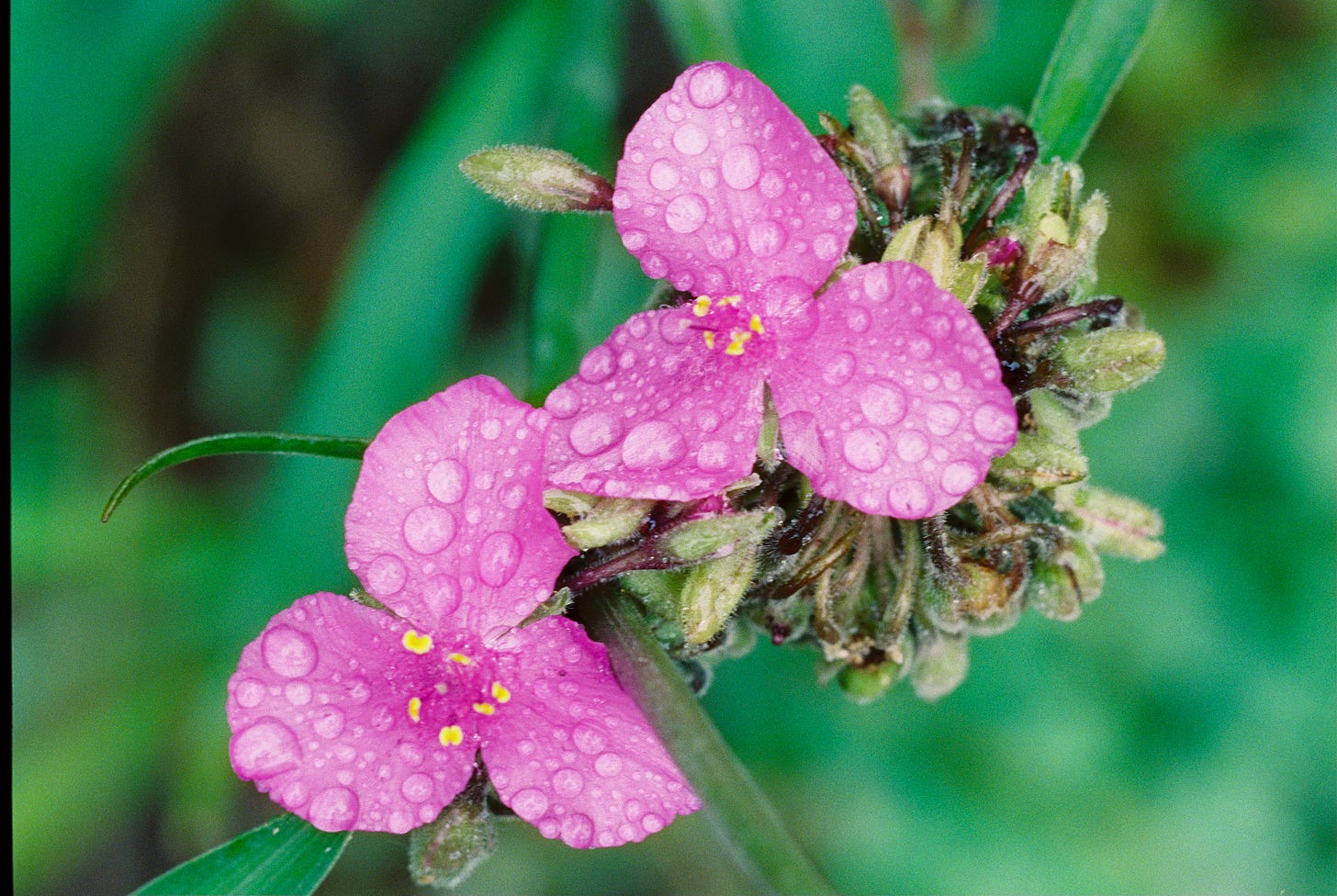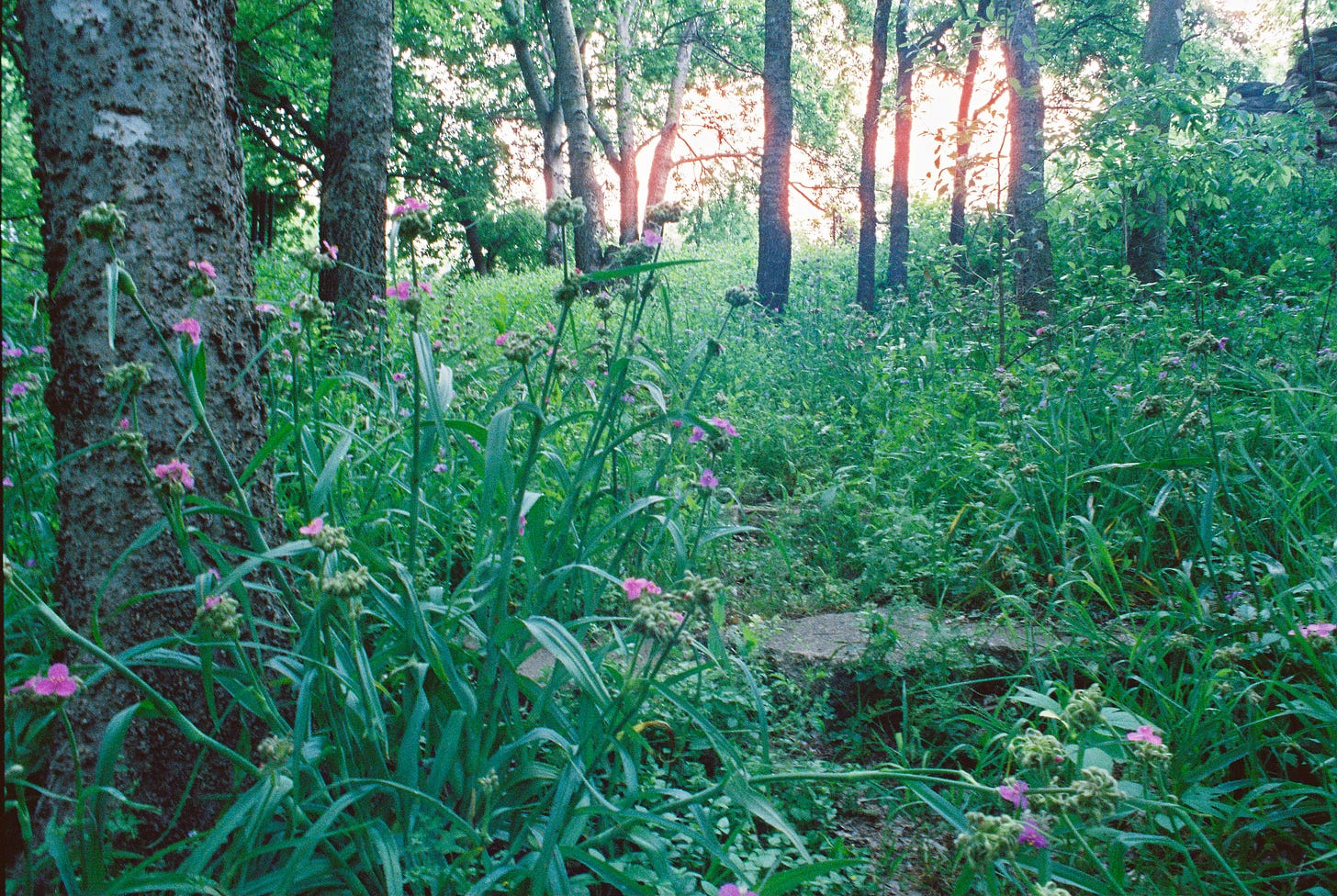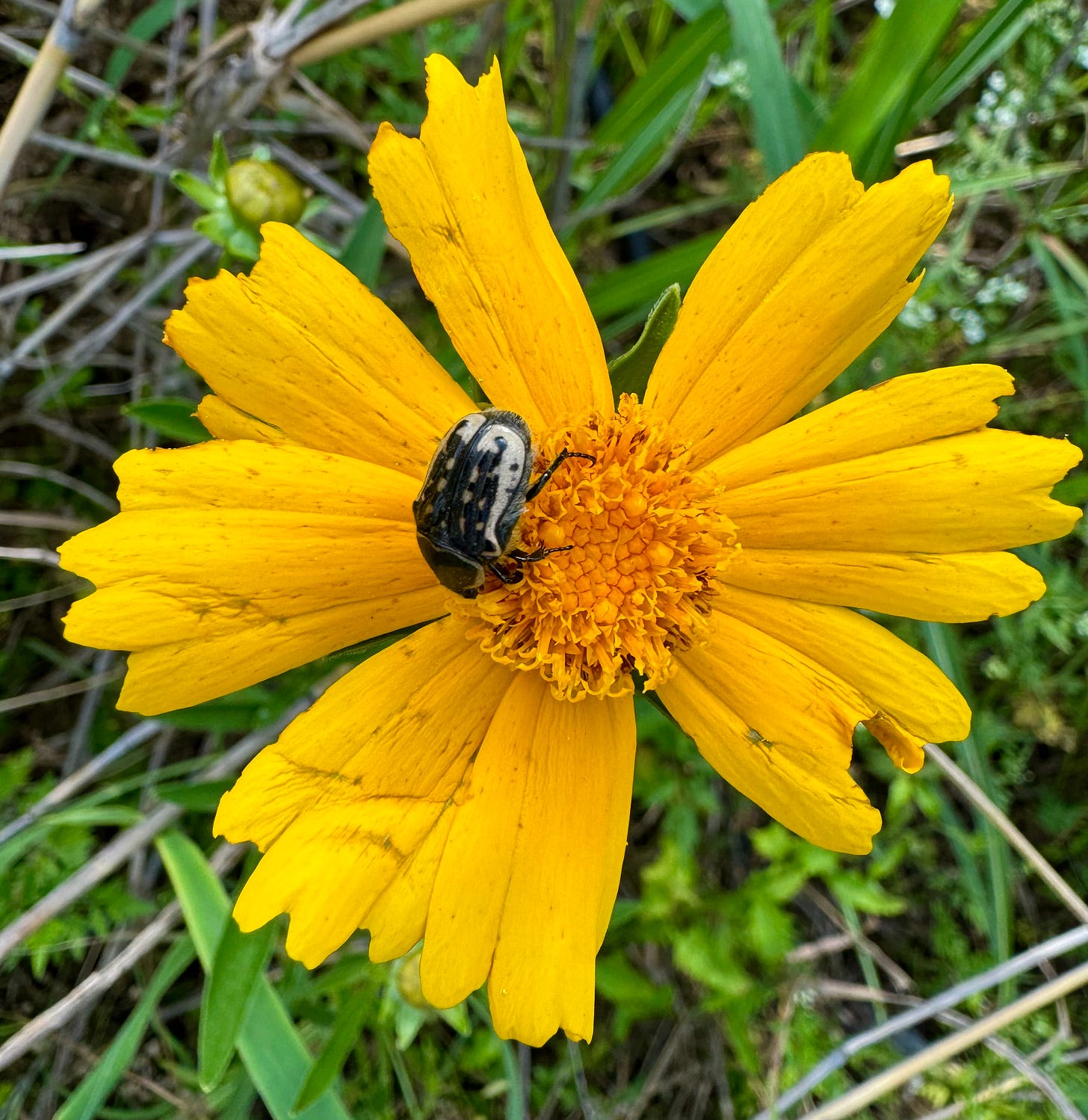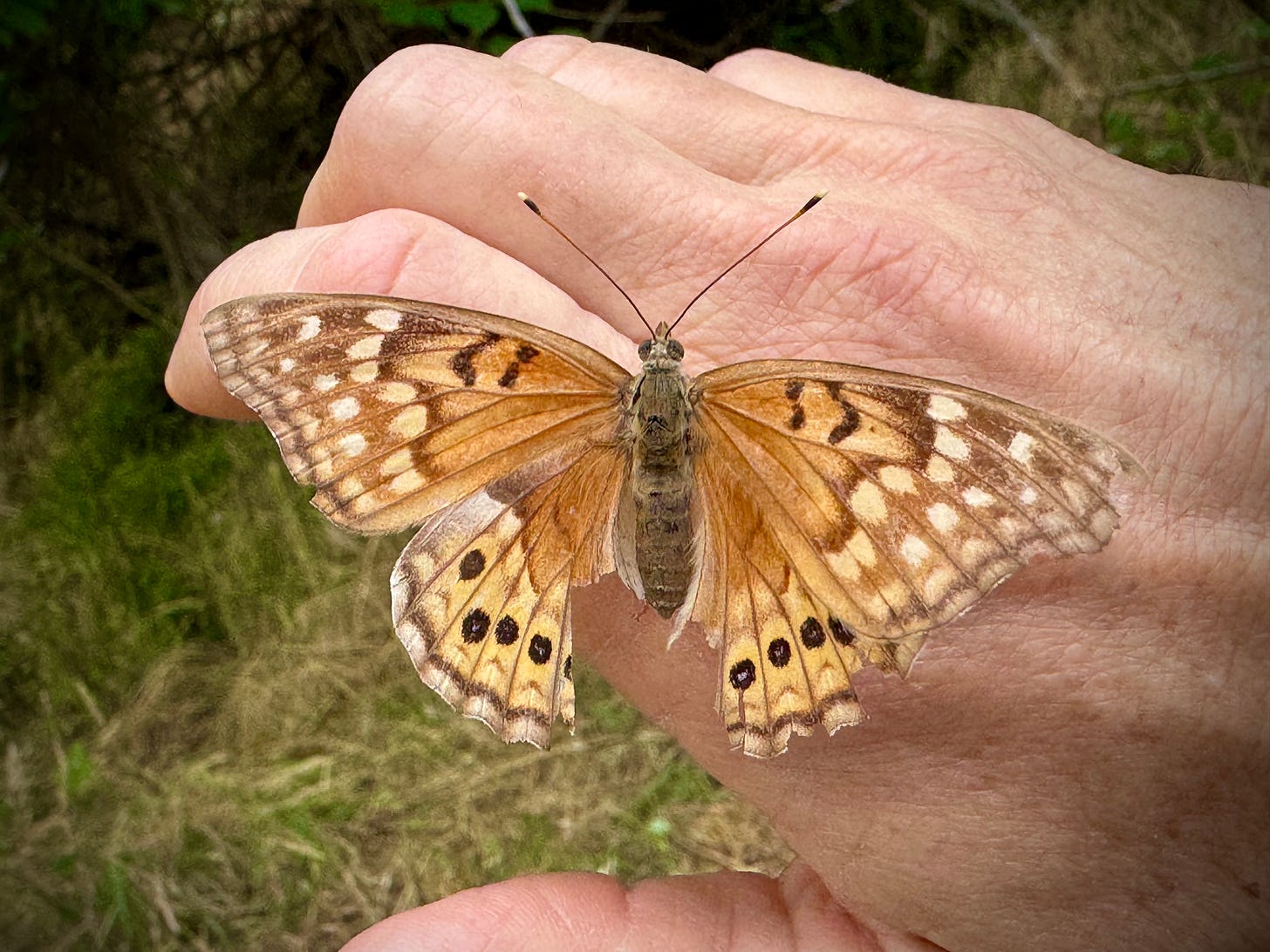Burn barrels, skunk tails and May Days
(No. 152)
The first wildflowers of the Midwestern spring were in bloom all across the savanna when I visited my mom the week before May Day on the occasion of her 84th birthday. Little flowers, mostly, more modest than we have in Texas, coming up out of the black earth a month after the burn, on cue for the real estate photographer who showed up that Friday to get shots for the listing. When I asked Mom what the little purple one was, she said it was Sweet William, without any acknowledgement of the way that could make me think she was talking about the guy she was married to for 60 years, and whose passing in the fall of 2022 is the main reason she seems ready to move on. Instead she said, more accurately, it’s a phlox.
My main mission on the trip, other than make my mom dinner on her birthday, was to help her get “organized,” our contemporary American euphemism for shedding your life of accumulated consumer goods. On the last trip I worked through the library, culling my dad’s collection of books about dentistry, wine, succeeding in business, and living forever, grabbing photos of the unintentionally self-parodic author jacket photos along the way.
This trip I went through the thirty-some boxes of books and personal effects relocated from my brother’s home and studio when he died five years ago. I only came up with two boxes to donate from the cull, and the rest filled back up the library shelves I had emptied on the prior trip, to be moved to Austin later—everything from Gerhard Richter coffee table books to old military modeling reference manuals, comics by painters and 80s alternative culture ephemera like the Amok Books catalog. I found a vintage Parker fountain pen of mine he had saved when I left it behind, along with a couple of my T-shirts from college. Alex was the sort who had a particular tuning to the emotional resonance and memory stored in ordinary objects. I’m normally more prone to excise the dead matter, but as I opened each box I could feel how he had turned these once unremarkable things into talismans.
Friday evening, after we got the chicken in the oven and before the Perry Mason reruns began, I started a fire in the burn barrel Mom had borrowed from one of her local friends, and finally attended to the shoeboxes full of old business receipts, tax returns and travel itineraries Alex had fastidiously kept. The financial records of the life of a painter and musician, with its unpredictable cash flow and ever-present worry. One manila folder from 2008 was hilariously marked “Unimportant Stuff.” Some future archivist may curse our decision to dispose of such materials, but it felt right as a cremation of care—of a working artist who was always worried about money (and getting audited), and of the mother of a dead son who had to walk by those boxes every time she did the laundry.
I got back to Austin late Saturday, rerouted around the storms that hovered over Dallas, and got going for a walk in the woods with the East Austin street retriever a little later than usual Sunday morning. A brief escape into the uncanny wonder of the urban woods seemed just the tonic. Until almost immediately, we were stopped by a skunk foraging on the path—inside the fence, just a few feet from the swingset.
Lupe, who is a canine senior citizen now, didn’t even seem to notice, sniffing around in the foliage a few feet behind me. But our animal neighbor noticed us coming down the path pictured below, me with my upright shadow, dangling leash and old film camera made of a material that feels and sounds a lot like gunmetal. The skunk and I both stopped and waited to see what the other would do, in one of those moments of inter-species encounters that slows time.
The first time I ever saw a skunk in real life was in the field between a dairy plant and an overpass here at the edge of East Austin, around 2012. And all I really saw was the tail, sticking straight up out of the tall grass like a periscope moving across the surface of the ocean. A warning, you could immediately intuit, by an animal that had noticed our dogs and their youthful predatory energy well before we got close enough to harm it. I doubt my dogs even saw the skunk, as hounds in a field like that put their noses to the ground, and even when they don’t, the unmowed grass in summer is usually too tall for them to see over.
In the decade that followed, walking in these urban woods and empty lots almost daily, I never saw a skunk, unless you count the occasional roadkill on the other side of the factories. Until last summer, when the skunks became suddenly more evident here in the riparian edgelands, foraging in daylight. Like this one I encountered in the peak of last summer’s heat, sniffing around in the prickly pear behind a construction zone across the river:
Skunks are more diminutive and cute in person than I might have expected, their black and white coats, once marketed as “Alaska sable,” both weirdly and unnaturally elegant—the opposite of camouflage—and dryly coarse and rough-looking. They seem pretty tolerant of your presence if you manifest no aggression. And more likely to be out in the daytime than the field guides, which usually refer to them as crepuscular creatures, would have you believe. Those books also indicate, more convincingly, that the skunks have few natural predators other than “hungry coyotes” and owls (which have “little sense of smell”). Perhaps that evolutionary advantage, no doubt a product of their unique and non-violent defense mechanism, along with their omnivorous diet, is why they seem to be suddenly proliferating in the feral interstices of Austin—zones where development pressure has, in recent years, been doing a pretty good job of pushing out the wild.
The name “skunk” is a good one. Like “opossum” (white dog), it’s a name that’s native to the North American land—one the early European settlers and explorers learned for the strange species they encountered on this far shore from the people who had long lived here. In the Algonquinian languages, “skunk” means something like “piss-fox,” and it’s one of those words whose phonemes seem to encode some of the natural sensory experience of the animal. A word that is also a warning, and a premonition of a trick.
The skunk Lupe and I encountered Sunday morning sized the situation up quickly and unhurriedly took cover nearby, in the shelter of a half-buried old chunk of concrete rubble covered by spiderwort, back in the part of our yard I call the Garden of Rebar—an ongoing experiment in seeing how nature can reclaim what once was an outlaw landfill. And as I looked at how well trod was the hole it had disappeared into, I wondered if that may be its permanent den. If the skunk may be living right outside our back door, taking advantage of the protection from predators our fence provides. That would explain how often we have been smelling those musky odors close by in the morning and evening.
The skunk won, and we walked on the street instead. And then Lupe kept me company as I attended to the spring weeding, the Sisyphean but always-rewarding effort to cull the invasives from our wild yard and green roof. I like to weed after the rain, because it makes the work so much easier. And as I pull the cow parsley, brome and gnarly thistles, I am often rewarded with the revelation of some native wildflower to the sun. Like this solitary honey daisy I came upon Sunday, its yellow as rich as the brief bloom of the huisache trees under which it often grows, trees from which you can make both an elegant perfume and a potent hallucinogen.
With its jagged, asymmetrical and chewed-off petals, the flower was a good example of a thing I have been thinking about a lot over the past year—how objects in nature are often imperfect and even a little bit broken, just like us. In a yard full of wild birds and lizards, one learns to notice over time, the grasshoppers are often missing a hind leg, but keep on hopping. And the butterflies often lose chunks of their hindwings, and keep on flying despite the aerodynamic impairment. On Sunday I watched a pipevine swallowtail with no hindwings at all, sucking at the fresh flowers of the red yucca. And last Friday this hackberry emperor missing a bite-sized chip landed on my hand down in the woods, in the shade of a fresh-fruiting mulberry tree on which its cousins were cavorting.
By the end of the week you could see the first retama blooms of the season, bright yellow flowers on a scrubby volunteer growing on the patch of dirt next to the loading dock of the door factory. A slightly brighter yellow than the honey daisies and the huisaches, on a thorny green tropical tree whose colors are a signal that spring is coming to and end, and the long hot summer is about to dial up.
May Day at the Movies
The imminence of summer was also evident in the end of the academic semester, as my wife spent the last week of April in long days of year-end student reviews at the UT-Austin School of Architecture. It insulated them from the tumult going on outside, as the university president and the governor dispatched state troopers to deal with peaceful protesters endeavoring to temporarily occupy the quadrangle at the heart of the campus sometimes referred to by its alumni as “the forty acres.” I had already been thinking how much this year seems to have echoes of 1968 running through it, and the events of this week brought that home. I recalled reading Norman Mailer’s Miami and the Siege of Chicago in the summer of 2018, and the all-American scene where William Styron and Terry Southern are having drinks in the bar of the Conrad Hilton when the cops chase protesters right through the plate glass windows and continue the beatings inside, as the patrons watch to the sound of “Mood Indigo.”
In that spirit, I managed to sneak out to the movies last week and catch a screening of Alex Garland’s Civil War, my curiosity piqued after a couple of folks on social media remarked on how much the movie reminded them of my 2017 novel Tropic of Kansas. In the scenes of everyday American vignettes overtaken by martial action, I could see why they said that, but my story was not so much about war as popular uprising, and the possibility (fantasy?) of achieving a more authentically inclusive and participatory democracy. At the same time, I could see how Garland and his co-creators found their way to some of the same territory, as they tried to bite into the copper wire that kind of speculative exploration exposes.
Many reviewers have knocked Garland for evading any real politics, choosing a storyline that on its surface seems to have no more traceable connection to contemporary partisan conflicts than some speculative tabletop wargame from the 1970s, with its Texas-California alliance at war with a third-term president whose policies are largely unmentioned. I think that misses the point. In its road trip through the American landscape with a quartet of picture-snapping journalists, the eye of the camera hints at the real politics of the continent, visiting oases of putative normalcy that reveal their horrors only when you probe farther than you are supposed to. At the end of every country road, there is blood in the soil. And (spoiler alert) behind that beautiful ranch with its expansive green lawns and split-timber fences, there is a mass grave, hiding the atrocities of the past in plain sight.
Beyond those sorts of metaphoric echoes of our living history, the movie didn’t connect the horrors of how we treat each other with our damaged relationship with the land. But the title sequence, in which the camera pans back to show black plumes of smoke rising across the river from the Manhattan skyline, reminded me of the description I had read last month in Shepherd Krech’s book The Ecological Indian, of how the Dutch mariners who first explored the Atlantic coast in the early 17th century reported seeing smoke rising from a land they described as being so managed by the use of fire that it could be “smelt before it is seen.”
Some of the early 17th century settlers of New England brought their May Day traditions with them to the burning land—often the same settlers who seemed, at least in their early experiments before they were pushed out by the Puritans, to want to peacefully co-exist with the Native peoples who already occupied the continent. Later immigrants to the industrialized country the descendants of the Pilgrims made brought different May Day traditions, from a Europe living through waves of revolutionary change and aspirations for utopia. The science fiction writer in me likes to imagine a future in which those traditions of nature worship and emancipatory politics interbreed in some new intersectional holiday that seeds a fresh way of thinking about how we live. But every year May Day comes and goes as just another work day, both traditions successfully suppressed.
Seeing the newest generation of American adults awaken to the horrors colonial conflict can bring, I wonder if they may be equally able to see the less manifest mirrors of those horrors that are evident right here in the occupied territory we call our home. And if they will be able to imagine a path to a more just future, for our species and those we share the planet with. Hopefully it will not require the burning of anything other than the winter weeds that colonized the land alongside us and extinguished the native life you can still see holding out in the margins.
Further Reading
Thanks to the folks at Beaverdale Books for tipping me off to the local poetry festival in Des Moines the weekend I was in the area visiting my mom, which I was able to drop in before catching my flight home. The theme was poetry of nature and place, and I got to hear an excellent lunchtime panel on eco-poetry headlined by Camille Dungy, whose anthology Black Nature is a favorite of mine, and joined by Debra Marquart, Kansas Poet Laureate Traci Brimhall, Paul Brooke, Jennifer Knox, and moderator Caleb Rainey. The discussion of how time in the Midwestern landscape, with its “absence of charismatic geology,” makes one work harder as a descriptive writer, was particularly resonant. I got to briefly meet Camille Dungy in the hallway after the panel, added her new book Soil to my reading list, and read from Jennifer Knox’s terrific collection Crushing It on the way home.
For a great roundup of the literary write-ups of the 1968 Chicago Democratic Convention and police actions, check out this Christian Lorentzen piece from the Summer 2018 issue of Bookforum.
On May Day and its connection to the American landscape, this Peter Mancall piece at Atlas Obscura on Thomas Morton, the May-pole of colonial era Quincy, and the violence of the Puritans, is an interesting gateway to further reading. See also my post “May Day in the Edgelands” from May 2, 2021.
The May Day print edition of the NYT had an interesting piece about the successful battle to preserve the Cochamó Valley in Chile from development, this time led by local activists instead of noble-minded North Americans.
Closer to home, thanks to Mike Bayer for the link to this San Antonio Express-News report about the remarkable return of river otters to Central Texas rivers.
And kudos to Rebecca Wisent for this upcoming directory she has announced of all the nature writing on Substack—I’m excited to see what she inventories, and what I’ve been missing.
Lastly, I was delighted to learn that Simon & Schuster, under the editorial direction of Joe Monti at Saga Press, is bringing my favorite new book of 2023, M. John Harrison’s Wish I Was Here, out in the US (the original edition was UK only). If you like reading about edgelands, writing, climbing, Ballardian condensed novels, or memoir that transcends the self, you should love this book. Coming September 3 and now available for preorder.
A month later you’ll be able to read my new book, A Natural History of Empty Lots, which draws on the same material as this newsletter. I just got the page proofs Friday, and the design is absolutely gorgeous. Plans are also coming along for the audiobook edition, which I’m excited about. In the meantime, I’m hoping to get the first print version of this newsletter, available to readers who preorder the book (and let me know by email to chris@christopherbrown.com, along with their snail mail address), pulled together in the next month or so. The response to that has been so enthusiastic that I’m aiming to do at least three print zine issues before the launch.
Have a beautiful week, and enjoy the rain if you’re lucky enough to get some. I hope to be back next week with a report from the coast.
🦋










Nice job, Chris. I enjoy these reports from the margins, and the array of related links as well. Cool house too! (I saw pics of it somewhere.) Best of luck with a new book.
Jim Bourne
PEA82
So much here, I shall limit my comment to agreement about the overwhelming cuteness of skunks. Happy to learn that their name and that of opossum are Native in origin, that is as it should be. Piss fox seems a bit harsh but then I’ve not had the full skunk experience….